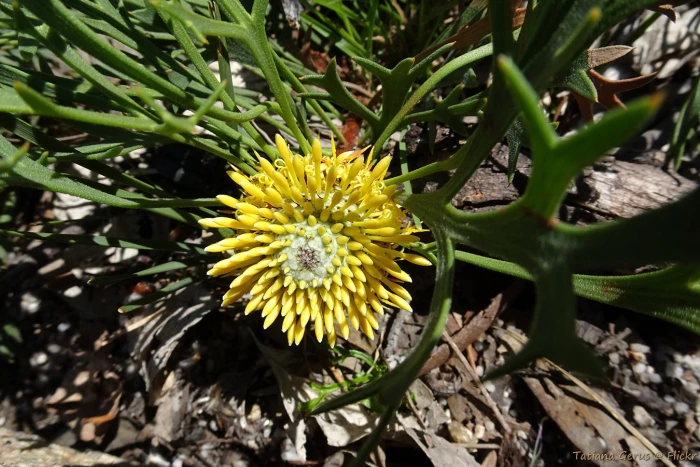Drumsticks
(Isopogon petiolaris)
Drumsticks (Isopogon petiolaris)
/
/

Tatters
CC BY-SA 2.0
Image By:
Tatters
Recorded By:
Copyright:
CC BY-SA 2.0
Copyright Notice:
Photo by: Tatters | License Type: CC BY-SA 2.0 | License URL: https://creativecommons.org/licenses/by-sa/2.0/ | Uploader: Tatters | Publisher: Flickr |














Estimated Native Range
Climate Requirements for Cutler Bay, Florida
| This Plant | Your Site | Plant Suitability for Your Location | ||
|---|---|---|---|---|
| • Precipitation | 23" - 62" | 57" | Aquatic | Aquatic |
| • High Temp. | 74°F - 92°F | 90°F | Your summer temperatures are normal for this plant. | Excellent |
| • Low Temp. | 33°F - 50°F | 59°F | OK, but your winter temperatures are warmer than normal for this plant | OK |
This plant may not grow well at your location - your precipitation is too high.
Summary
Isopogon petiolaris, commonly known as Drumsticks, is an evergreen shrub native to the open sclerophyll forests and heathlands of Eastern Australia. It typically grows to a height of less than 1 meter (3 feet 3 inches) and features reddish-brown branchlets. The plant is characterized by its sharply-pointed, divided leaves and spherical heads of bright yellow flowers that bloom in spring and summer, adding a splash of color to the garden. The flowers are particularly showy, attracting various pollinators.
Drumsticks are valued for their unique spherical flower heads and low maintenance requirements. They are often used in native plant gardens, rockeries, and as a feature plant in mixed borders. This shrub is adapted to poor, sandy soils and is drought-tolerant once established, making it suitable for xeriscaping. It thrives in full sun to part shade and requires well-drained soils. While generally pest-free, it can be susceptible to root rot in poorly drained conditions. Drumsticks can be propagated from seed or cuttings, though seeds require smoke treatment for germination.CC BY-SA 4.0
Drumsticks are valued for their unique spherical flower heads and low maintenance requirements. They are often used in native plant gardens, rockeries, and as a feature plant in mixed borders. This shrub is adapted to poor, sandy soils and is drought-tolerant once established, making it suitable for xeriscaping. It thrives in full sun to part shade and requires well-drained soils. While generally pest-free, it can be susceptible to root rot in poorly drained conditions. Drumsticks can be propagated from seed or cuttings, though seeds require smoke treatment for germination.CC BY-SA 4.0
Plant Description
- Plant Type: Shrub
- Height: 2-3 feet
- Width: 2-4 feet
- Growth Rate: Moderate
- Flower Color: Yellow
- Flowering Season: Spring, Summer
- Leaf Retention: Evergreen
Growth Requirements
- Sun: Full Sun, Part Shade
- Water: Low
- Drainage: Fast
Common Uses
Bee Garden, Bird Garden, Butterfly Garden, Low Maintenance, Rock Garden, Showy Flowers
Natural Habitat
Open sclerophyll forests and heathlands
Other Names
Common Names:
Scientific Names: Isopogon petiolaris, Atylus petiolaris, Isopogon anemonifolius var. ceratophylloides
GBIF Accepted Name: Isopogon petiolaris A.Cunn. ex R.Br.